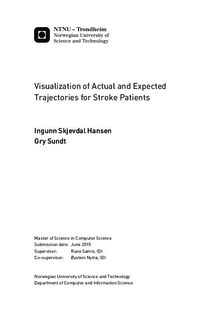Visualization of Actual and Expected Trajectories for Stroke Patients
Master thesis
Permanent lenke
http://hdl.handle.net/11250/2353517Utgivelsesdato
2015Metadata
Vis full innførselSamlinger
Sammendrag
As people consult the health care sector, the amount of data registered in their health records increase. The interest for insight into the medical journals is increasing. It can be strenuous for the patients to understand their own journals, and a support system is needed to make the data more manageable to grasp. Previously, the focus has been on developing systems for the clinicians and help them make clinical decisions. This master thesis focuses on the patients, providing a helpful tool to better understand their own health situation. The focus was on patients who received treatment for after having suffered a stroke. It was attempted to find the best method for visualizing the patient's health records. Possible solutions for the visualization were revealed by conducting a literature review and a workshop, and usability testing. The result was a timeline containing 1) the individual patient's health records, 2) the stroke guidelines, and 3) the typical contacts based on a group of similar patients. The stroke guidelines were incorporated into the visualization in order to give a comparable element to the patient's stroke treatment. Patients who are still receiving treatment for their stroke may draw benefits from the guidelines by seeing what will be the next stages in the treatment. Additionally, similar stroke patients were grouped together in order to find similarities in their treatments. The similarities were used to visualize the visits which were most probable of occurring in a stroke treatment. In conclusion, the project provides useful methods for handling large amounts of medical data and visualizing the data to the users.
